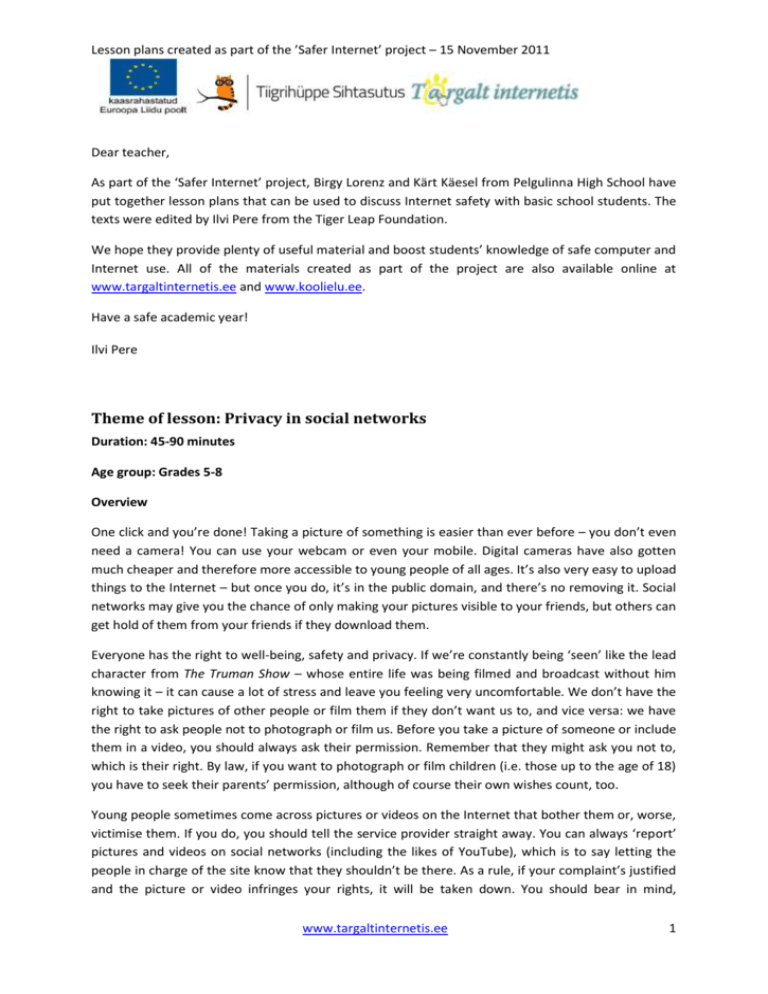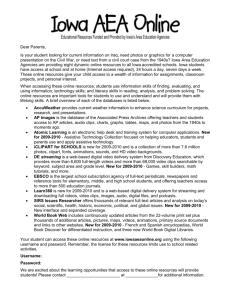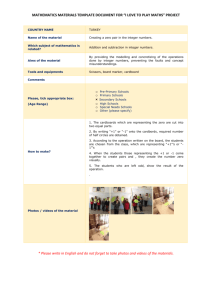Lesson plans created as part of the 'Safer Internet' project – 15
advertisement

Lesson plans created as part of the ’Safer Internet’ project – 15 November 2011 Dear teacher, As part of the ‘Safer Internet’ project, Birgy Lorenz and Kärt Käesel from Pelgulinna High School have put together lesson plans that can be used to discuss Internet safety with basic school students. The texts were edited by Ilvi Pere from the Tiger Leap Foundation. We hope they provide plenty of useful material and boost students’ knowledge of safe computer and Internet use. All of the materials created as part of the project are also available online at www.targaltinternetis.ee and www.koolielu.ee. Have a safe academic year! Ilvi Pere Theme of lesson: Privacy in social networks Duration: 45-90 minutes Age group: Grades 5-8 Overview One click and you’re done! Taking a picture of something is easier than ever before – you don’t even need a camera! You can use your webcam or even your mobile. Digital cameras have also gotten much cheaper and therefore more accessible to young people of all ages. It’s also very easy to upload things to the Internet – but once you do, it’s in the public domain, and there’s no removing it. Social networks may give you the chance of only making your pictures visible to your friends, but others can get hold of them from your friends if they download them. Everyone has the right to well-being, safety and privacy. If we’re constantly being ‘seen’ like the lead character from The Truman Show – whose entire life was being filmed and broadcast without him knowing it – it can cause a lot of stress and leave you feeling very uncomfortable. We don’t have the right to take pictures of other people or film them if they don’t want us to, and vice versa: we have the right to ask people not to photograph or film us. Before you take a picture of someone or include them in a video, you should always ask their permission. Remember that they might ask you not to, which is their right. By law, if you want to photograph or film children (i.e. those up to the age of 18) you have to seek their parents’ permission, although of course their own wishes count, too. Young people sometimes come across pictures or videos on the Internet that bother them or, worse, victimise them. If you do, you should tell the service provider straight away. You can always ‘report’ pictures and videos on social networks (including the likes of YouTube), which is to say letting the people in charge of the site know that they shouldn’t be there. As a rule, if your complaint’s justified and the picture or video infringes your rights, it will be taken down. You should bear in mind, www.targaltinternetis.ee 1 Lesson plans created as part of the ’Safer Internet’ project – 15 November 2011 however, that the picture or video might not disappear for good – someone may well have already made a copy of it. But at least people won’t be able to find it any more, and you’re not allowed to share pictures and videos without the consent of the person who created them. If that’s you, copyright laws can help you stop them being spread around. Sometimes you might find a picture or video funny (or sexy or provocative or daring or silly – whatever it might be, in your opinion at least) and so you upload it. At first everyone might agree with you, but in the long run it could come back to haunt you. What if someone you don’t know sees it, doesn’t get the joke and thinks that’s what you’re really like? Would you want them to think that about you? The Internet is everywhere, and anything you post could end up being seen by your teachers, your parents, your relatives, future employers, shady characters you’ve never met before (who then start paying you unwanted attention or even threatening you)... Aims Students grasp the issue of privacy, their right to ask others not to take pictures of them or film them and their obligation to ask others for their permission to take photos or film them. Students appreciate people’s concerns in regard to Internet privacy, can deal with them personally and can help others overcome them. Students know how to report photos and videos uploaded to social networks (including YouTube) which are inappropriate, and know where else to seek help if they need it (e.g. the Online Constable). Previous knowledge required: understanding or experience of taking photos and photos and videos posted online The teacher will need: a computer and the Internet to show the films below to the students The students will need: note paper (e.g. post-it notes), a pen and paper and felt-tip pens etc. for design work Activities Duration Introduction 3 minutes Greet the class and introduce the lesson: “Do you know anyone who knows anyone who’s seen pictures or videos of themselves on the Internet that bother them and that they didn’t give their permission for the person to take or film? Is there anyone who doesn’t know somebody like that?” Tell the students that they’ll be putting together a manual (guidelines/recommendations) on taking photos and filming videos at school. Themes and tasks 8 minutes Show the students the animated short entitled Kasukata /Fleeced/ at http://et.sheeplive.eu/fairytales/kasukata. Discuss what happened in the film with the class: “How could it have been www.targaltinternetis.ee 2 Lesson plans created as part of the ’Safer Internet’ project – 15 November 2011 avoided?” Outline the topic of privacy using the themes raised in the introduction above. Independent work and class summary Hand the note paper out to the students. Explain the task: “Think about the kinds of things that would worry young people most about being photographed or filmed and those photos and videos being spread around online. Compare your thoughts with a partner. Note down the most important points to you on the paper I’ve given you.” Collect the note paper or post-it notes on a single larger sheet and work with the class to group similar ideas and come up with a name for them. Check that all of the key points have been raised, adding any where necessary. Group work Divide the class up into groups of 4-5 students. Show the students the animated shorts entitled Ära tantsi koos huntidega /No Dances With Wolves/ at http://et.sheeplive.eu/fairytales/ara-tantsikoos-huntidega and Röhitseja /Burp!/ at http://et.sheeplive.eu/fairytales/rohitseja. Each group draws up a list of proposals on what to do should such a situation arise and what to do to avoid it arising in the first place. Each group presents 1 or 2 of their ideas (preferably without repeating any that have already been made). Work with the class to summarise them and come up with a list of 5-6 rules/recommendations for taking photos or filming videos at school so as to prevent any problems in this area. Each group should then be given paper and felt-tip pens etc. and allocated 1 rule/recommendation. They then design their rule/recommendation as they like, all of which are then stuck together, making guidelines for the class on taking photos and filming videos at school. Assessment The students’ participation in the lesson, their group work and the results of discussions The work they design The homework they do and drawing up the list of recommendations with the class Giving anonymous examples from everyday life and making connections Homework Ask your family and friends outside of class what they’d be most worried about in terms of photos and videos that end up on the Internet. How would they deal with such a situation? Draw up a list of recommendations for your friends along the lines of ‘What should I do if this happens to me?’ www.targaltinternetis.ee 5 minutes ? 23 minutes 3 minutes 3 minutes 3






